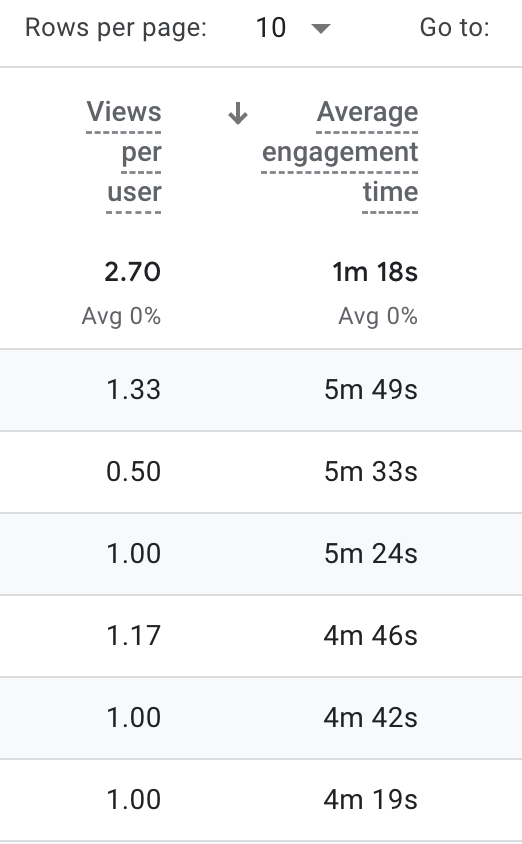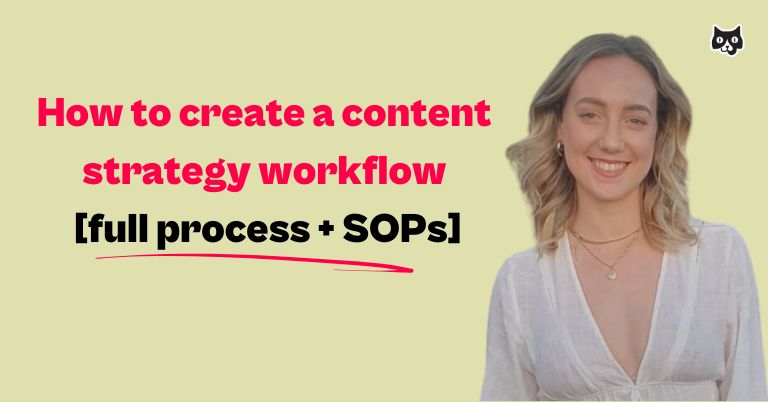Your content is your brand. Every blog post, product page, listicle, and round-up you put out into the world represents your company and the goals that you want to achieve. At Flying Cat, we rely on our well-structured workflows to create in-depth, highly researched strategies that reflect our client’s brand and help them establish SEO as a revenue-generating marketing channel.
That sounds pretty good, doesn’t it? Ok, so how do you create a stand out content strategy?
With so many approaches to content strategies and marketing, knowing where to begin can seem like trying to climb Mount Everest without a guide. Here, we’ll provide you with the tools to take the first step towards Base Camp 1, also known as a content strategy. And if you need some more guidance? There’s an SOP for that.
What is a content strategy workflow?
It’s an action plan guiding the creation, publication and distribution of content, helping you achieve your business goals.
I spoke to Terry Stancheva, SEO Strategist at Flying Cat Marketing, to understand how she builds a content strategy for her clients.
Her first step?
“The first thing I do is to check their website and understand what the business is all about. The first thing is to really understand who they are, what they do, what they’re offering and to who”.
After all, how can you create a strategy if you don’t know who you’re creating it for?
Defining goals
Creating a content strategy without defined goals is like driving without Google Maps. It’s possible, but it’s going to be really hard to arrive at the right destination.
More traffic, more leads, more conversions – what do you want to achieve?
Maybe you have a ton of traffic coming to your website, but it’s not converting. You might need to focus on bottom of the funnel, product-related content that convinces customers to buy. If you’re trying to get more eyes on your product, you might need a strategy that relies on more top of the funnel content. Be realistic about what stage your business is at. If you have a brand new website with very little traffic and you’re all steam ahead for conversions, you’re going to end up disappointed.
Begin with the end in mind. If you already know what you want to achieve with your content strategy, this is half the battle. From here, you can begin the process of ideating and researching.
Ideation and keyword research
Know your audience, know your solution
If you’re not speaking to your customers about their experience with your brand, you have an untapped goldmine of knowledge already at your fingertips. Every customer has a reason that sold them on your product.
Set up interviews with your customers and ask them for their feedback:
- What drove them to buy your product?
- Why did they choose you over a competitor?
- What is the main problem that your product solves for them?
Ask your sales team to pass on the most common objections that they hear in sales calls against your product. Dive as deeply as you possibly can into the information that your customers provide you. The more you understand about your customers’ pain points, the more material you have to offer a solution.
Use your competitors
Use a tool like Ahref’s Competitive Analysis Tool to conduct a content gap analysis and identify what kind of content your top competitors are creating. What’s missing from your current strategy that could be really beneficial to achieving your goals? Understanding what works for your competitors is a great method of identifying what kind of content works best for your industry.
Don’t stop here though. Go beyond just your direct competitors. One of Terry’s favorite tricks is to check out indirect competitors.
“Something that I really love doing is looking at indirect competitors because they’re always there, but they’re hidden. A lot of marketers don’t consider them. It’s not only about competitors. It’s about who is solving the same issue as you”.
What other solutions are available, even if they’re not so apparent. Don’t limit yourself to the obvious features that you offer. What else do you want your customers to talk about? What else can you change? Going beyond what’s right in front of you and discovering all the possible problems and all the possible solutions will give you a ton of content opportunities.
Keyword research
How you do your keyword research is as personal as how you like your eggs for breakfast. Just in case you need some inspiration though, here are some tried and true methods that I particularly like:
- Ahrefs Content Explorer for ideas on topics that you’ve discovered in your research
- Ahrefs Keyword Explorer for bulk informational keywords
- Google suggest and partial search assistant
- Networking and communities. Type your keyword and competitor’s names into online communities and check out what recommendations people leave when looking for solutions to their problems.
Once your research is done and you’ve got a list of keywords at the ready, you can start turning them into topics and creating content. Check out our SEO toolkits with full guidance on these techniques.
Creating your content
The goals are set, customer research is done, the list of keywords is finalized. Now it’s time to get your writing cap on. Determining what kind of content to create, how much content and how often to publish will depend, once again, on your goals. The actual creation of that content should be backed up by a solid content management workflow.
This phase is an ideal opportunity to involve different members of your team and subject matter experts who can provide unique insights into the topics that you’ve selected. My favorite part of the content creation process is speaking to experts on their opinions, tricks of the trade and watching how passionately they speak on their area of expertise.
Once you’ve established a rock solid content creation process, don’t stray from that path. It’s much easier to keep on top of things when you know who’s responsible for what.
A word on search intent
I’ve heard this so many times, I’ve lost count so I think it’s important to mention here.
“If your content doesn’t match search intent, it won’t rank”.
Google wants to do one thing: Give readers the answer to what they’re searching for. You can put as much effort into keyword research as you want, but if you don’t give the searcher the information they’re looking for, you’re wasting your time.
Let’s take recipe websites for example, I love to try new dishes and foods and I’m always looking for a different recipe to try. There’s nothing more annoying than clicking recipe that looks yummy, only to have to sift through paragraphs and paragraphs of text about where the frittata was invented and its health benefits. The moment I see a page like this, I click out of it. All I want is a list of ingredients and a method. Nothing more, nothing less.
The same goes for the content you create for your product or service. Perhaps you have the best mobile scheduling app known to man, but if you begin a blog post about scheduling by going on a tangent about something totally unrelated your reader is going to get bored and leave.
In order to offer relevant, useful information to potential customers, nailing search intent is crucial. Before you decide on the final keywords make sure you understand:
- Which format the searcher was looking for when they typed their query into the search bar (examples, how to, a guide etc.)?
- Who exactly is searching? The person buying the product or the end user?
- What kind of content is ranking at the top (listicles, pillar pages, product pages, alternatives pages)?
Measuring performance
This is the moment of truth. You’ve put all this effort into crafting a beautiful strategy, the blog posts are written and published. Now, it’s time to see if it actually worked.
When it comes to measuring and reporting on performance, it’s key to ensure that you’re tracking all the metrics that key stakeholders want to see. Your boss has probably got a boss that wants to know if their investment is paying off. Refer back to the goals that you set at the beginning of the strategy.
Some key metrics to keep an eye on are:
- Traffic
- Click-through-rate
- Leads (Depending on you what you consider a lead)
- Conversions (Again, depending on what qualifies as a conversion for you)
- Top pages, top keywords
Other clues as to how your content is performing:
- Average engagement time
- Session duration
- Bounce rate
- Pages seen by user (indicates the ease of navigation of your website)

This will give you a snapshot of the overall performance of your strategy and you can use this data to dive deeper into what works and what doesn’t. It also provides you with a major ace up your sleeve when you want to convince your boss to give you more budget.
Create a stellar strategy by tailoring it to your unique situation
Content goes beyond ranking in SERPs, beyond search volume, beyond what keyword tools tell you about search volume. Customers want to feel like they’re learning something new. They’re coming to you for guidance and therein lies your chance to present them with the solution they don’t even know they’re looking for.
Creating content for content’s sake just results in a lot of useless information floating around. Every piece of content you create should be relevant, expert, trustworthy and above all, useful. If it’s not providing value, it’s not worth creating.
Following a well-thought out workflow to build your strategy ensures that you fully understand each action that you’re going to take to achieve the goals that you set out at the beginning of the process. Relying on your customers for feedback, understanding their pain points, understanding what solutions you offer, being an expert at every level of your brand and product means that you can be sure you’re on to a winning strategy.
